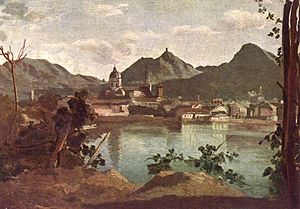Pliny the Elder facts for kids
Quick facts for kids
Pliny the Elder
Gaius Plinius Secundus |
|
|---|---|
 |
|
| Born | AD 23 or 24 |
| Died | AD 79 (aged 55) Stabiae, Roman Italy, Roman Empire
|
| Citizenship | Roman |
| Education | Rhetoric, grammar |
| Occupation | Lawyer, author, natural philosopher, naturalist, military commander, provincial governor |
|
Notable work
|
Naturalis Historia |
| Children | Pliny the Younger (nephew, later adopted son) |
| Parent(s) | Gaius Plinius Celer and Marcella |
Gaius Plinius Secundus (born around AD 23 or 24, died AD 79), known as Pliny the Elder, was a famous Roman author, naturalist, and military commander. He was also a close friend of the Roman emperor Vespasian. Pliny wrote a huge encyclopedia called Naturalis Historia (which means Natural History). This book became a guide for many encyclopedias that came after it. Pliny loved to spend his free time studying, writing, and exploring nature and geography.
One of Pliny's important works was a twenty-volume book called Bella Germaniae (The History of the German Wars). This book is now lost, but other famous Roman historians like Plutarch, Tacitus, and Suetonius used it as a source for their own writings.
Pliny the Elder died in AD 79 in Stabiae. He was trying to rescue a friend and their family during the huge eruption of Mount Vesuvius.
Contents
Pliny's Early Life and Family
When and Where Was Pliny Born?
Pliny was born around AD 23 or 24. We know this because his nephew said Pliny died in his 56th year, and we know he died during the eruption of Mount Vesuvius in AD 79.
Pliny's parents were Gaius Plinius Celer and Marcella. He was born in Como, a city in what is now Italy. A statue of Pliny on the Como Cathedral celebrates him as a local hero.
Pliny had a sister named Plinia. She married into the Caecilii family and was the mother of his famous nephew, Pliny the Younger. Pliny the Younger's letters tell us a lot about his uncle's daily life and studies.
Pliny the Elder never married and had no children of his own. In his will, he adopted his nephew, Pliny the Younger. This meant his nephew inherited everything. For some time, Pliny the Elder lived in the same house in Miseno with his sister and nephew. They were all living there when Mount Vesuvius erupted.
Pliny's Education and Early Career
Pliny's father took him to Rome to study law. Pliny became a lawyer and also studied grammar and public speaking.
Pliny's Military Career
Becoming a Junior Officer
In AD 46, when he was about 23, Pliny joined the Roman army as a junior officer. This was common for young men from wealthy families. He served in Germania Inferior (a Roman province in what is now Germany and the Netherlands).
In AD 47, Pliny helped with the Roman conquest of the Chauci people and the building of a canal between the Maas and Rhine rivers. He wrote about seeing Roman ships having to push away floating trees at night, which sounds like he saw it himself!
Serving as a Military Tribune
Later, Pliny was moved to Germania Superior (another Roman province) and promoted to military tribune. This was a staff job where he worked closely with the commander, Publius Pomponius Secundus. Pomponius was also a writer, and they became good friends. Pliny probably took part in a military campaign against the Chatti people in AD 50.
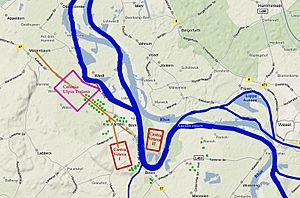
Commander of Cavalry
At some point, Pliny returned to Germania Inferior. This time, he was promoted to commander of a cavalry unit, which had about 480 men. He spent the rest of his military service there. A decorative piece of horse harness with his name on it was found at Castra Vetera, a large Roman army and naval base.
During his time in the army, Pliny wrote his first book. It was about how cavalry soldiers could throw spears from horseback. This book is now lost. He also started writing a history of all the wars between the Romans and the Germans.
Pliny's Life Under Emperor Nero
After his military service, Pliny did not hold any high government jobs for a while. This was during the rule of Emperor Nero, who was a dangerous person to be around. Pliny mostly lived in Rome during this time. He saw the building of Nero's huge "Golden House" after the Great Fire of Rome in AD 64.
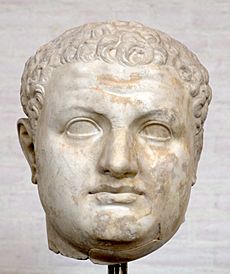
To stay safe, Pliny focused on writing about less risky topics like grammar and public speaking. He wrote a three-book guide on public speaking called Studiosus (The Student). He also wrote eight books called Dubii sermonis (Of Doubtful Phraseology). These books are also lost today. His nephew said Pliny wrote these books when it was dangerous to write anything too independent or important.
In AD 68, Nero took his own life, and his reign of terror ended. This meant Pliny could return to public service.
Pliny's Work for Emperor Vespasian
Serving as a Procurator
In AD 69, Vespasian became emperor. Vespasian was a successful general who needed loyal and skilled people to help him run the empire. Pliny was trusted and immediately given important jobs. He became a "procurator," which was like a governor of a Roman province.
Pliny probably served as a procurator in several provinces:
- Gallia Narbonensis (southeastern France) around AD 70.
- Africa Province (modern Tunisia) from AD 70 to 72. He wrote about things he saw there, like buildings made of molded earth and the fertile oasis of Gabès.
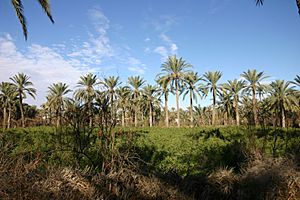
- Hispania Tarraconensis (Spain) from AD 72 to 74. While there, he learned a lot about farming and gold mines. His descriptions of gold mining methods in his Natural History seem to come from someone who saw them firsthand. He might have visited the mine at Las Médulas.
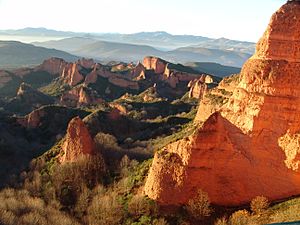
- Possibly Gallia Belgica (parts of modern Belgium, Netherlands, and Germany) from AD 74 to 76.
Pliny returned to Rome around AD 75 or 76. He was likely there for the first release of his Natural History in AD 77. Later, he was appointed commander of the Roman fleet at Miseno, where he lived with his sister and nephew.
Pliny's Famous Writings
Natural History
Pliny's last and most famous work was his Naturalis Historia (Natural History). This huge encyclopedia collected much of the knowledge of his time. Some historians believe it was the very first encyclopedia ever written. It had 37 books!
Pliny gathered information from his own experiences, his earlier writings, and notes from other books. He had servants who would read aloud to him while another servant wrote down what Pliny dictated. He even dictated notes while taking a bath! He collected about 160 volumes of these notes.
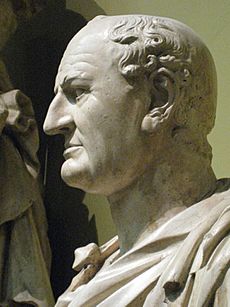
The Natural History was dedicated to Emperor Titus, Vespasian's son, in AD 77. The work was mostly finished by then.
Natural History is one of the largest single works from the Roman Empire that we still have today. It aimed to cover almost everything known in ancient times. Pliny claimed he was the only Roman to ever try such a huge project. It covers topics like:
- Plants (botany)
- Animals (zoology)
- Stars (astronomy)
- Rocks and Earth (geology and mineralogy)
- How people used natural resources
This book is still a very important source for understanding the Roman period and their advancements in technology and science. For example, it's the only source for some inventions, like using water mills to crush grain. Much of what Pliny wrote has been proven true by archaeology. It also describes the work of artists from his time, making it a key book for art history.
Why Natural History Is So Important
Many historians consider Natural History to be the first encyclopedia. It is certainly the earliest one that has survived. While there were other ancient history books, Pliny's Natural History stands out because it tried to cover every topic. It was clearly designed to be a reference book.
Modern experts still use Natural History to understand what various things meant in first-century Rome. They can compare unknown objects from other ancient texts to Pliny's descriptions. The book also helps us understand the traditions, beliefs, and even prejudices of Ancient Rome.
Natural History became a model for all later encyclopedias. It showed how important it was to cover many subjects, mention original authors, and include a full list of contents. It is the only one of Pliny's works that has survived. He died suddenly before he could make a final review of it.
Pliny's Death at Mount Vesuvius
Pliny was the commander of the Roman fleet stationed at Miseno when Mount Vesuvius erupted in AD 79. He received a message from his friend Rectina, who was stuck in Stabiae because of the eruption. Pliny immediately organized a rescue mission.
He boarded one of his ships and sailed across the Gulf of Naples towards Stabiae. As his ship got closer to the shore near Herculaneum, ash and small rocks started falling. His helmsman suggested turning back, but Pliny famously said, "Fortune favours the bold; steer to where Pomponianus is."
When they reached Stabiae, they found Senator Pomponianus. They had supper, and Pliny tried to rest. Early the next day, he woke up to falling stones and ash, and probably an earthquake. They decided to leave the house and go to the fields, using pillows on their heads to protect themselves from the falling debris.
They rushed to the shore, but the sea was rough. A cloud of hot, poisonous gases then covered them. Pliny, who was a bit heavy and had a breathing problem (possibly asthma), died from breathing in these toxic gases. His body was found three days later, with no visible injuries.
Twenty-seven years later, Pliny the Younger wrote a letter to the historian Tacitus, describing his uncle's death based on what survivors from Stabiae had told him.
Some later writers had different ideas about Pliny's death. For example, Suetonius wrote that Pliny went to the shore only out of scientific interest and then asked a slave to kill him to avoid the volcano's heat. However, modern historians and scientists believe he died from a medical condition like a stroke or heart attack, made worse by the stressful situation and the gases.
Images for kids
See also
 In Spanish: Plinio el Viejo para niños
In Spanish: Plinio el Viejo para niños


